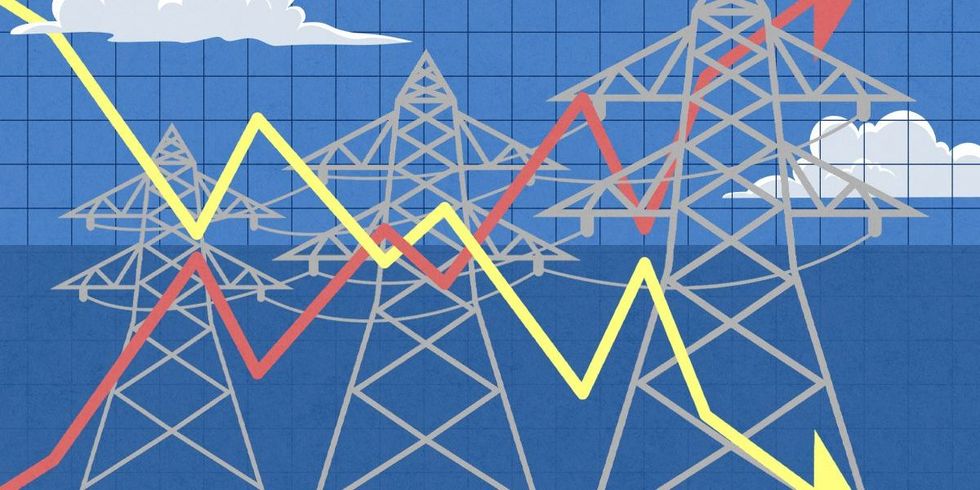
Constellation’s CEO Opts Out of Load Growth Mania
Just how big is the data center boom, really? How much is electricity demand going to expand over the coming decades? Business plans, government policy, and alarming environmental forecasts are all based on the idea that we’re on an unrelenting ride upwards in terms of electricity use, especially from data centers used to power artificial intelligence.
It’s one reason why the new Trump administration declared in the first days of its return to power that the country was in an “energy emergency,” and hasbeen used as a justification for its attempted revival of the coal industry.
But one mildly dissenting voice came from a perhaps-unexpected corner: the power industry.
Constellation Energy’s Chief Executive Officer Joseph Dominguez spent a portion of the company’s quarterly earnings call Tuesday throwing lukewarm water on the most aggressive load growth projections, even as the company looks to profit from increased demand for the power that its over 30,000-megawatt, largely nuclear fleet serves.
Dominguez told his audience of investors and analysts that utilities and their power customers have been telling Constellation that “the same data center need is being considered in multiple jurisdictions across the United States at the same time, just like fishing. If you’re a fisherman, you put a bunch of lines in the water to try to catch fish, and the data center developers are doing exactly the same thing.”
This means that different electricity markets or utility territories could report the same future data center demand, when ultimately the developer will pick just one site.
Tallying the demand growth projections from a few large power markets — namely MISO, which largely serves the Midwest; PJM, which largely serves the East Coast; and ERCOT, the Texas energy market — which together “account for less than half” of U.S. power demand, Dominguez said, Constellation finds that they project “notably higher” demand growth than many third-party consultants and analysts foresee for the country as a whole.
“It’s hard not to conclude that the headlines are inflated,” Dominguez said. He further claimed that Constellation had “done the math,” and that “if Nvidia were able to double its output and every single chip went to ERCOT, it still wouldn’t be enough chips to support some of the load forecasts.”
He argued that utilities tend to overstate load growth — an observation backed up by research from the Rocky Mountain Institute. “We get it,” he said. “Utilities have to plan to ensure that the system is reliable.” That frequently means erring on the side of having more generation and transmission to serve future demand as opposed to being caught short.
Dominguez is hardly the first voice to call into question load growth forecasts. Energy industry consultant Jonathan Koomey told Heatmap more than a year ago that “everyone needs to calm the heck down” about AI-driven load growth. Data center developers, chipmakers, and AI companies would likely find efficiencies to get more computing power out of less electric power, he predicted, similar to how the original data center buildout avoided catastrophic predictions of imminent power shortages and spiking electricity prices in the early 2000s.
Since then, demand growth projections have done nothing but rise. But even just a few weeks ago, Peter Freed, Meta’s former director of energy strategy, told Heatmap’s Shift Key podcast, “It is simultaneously true that I think this is going to be a really large demand driver and that we have bubble-like characteristics in terms of the amount of stuff that people are trying to get done.”
Now, to be clear, Dominguez has a reason to talk down expectations of future demand growth — and with it the expectation that there needs to be massive investment in new power plants. Constellation owns and operates a fleet of nuclear power plants, and is bringing on a gas-heavy fleet with its planned acquisition of Calpine.
Dominguez also said that new natural gas and renewables were likely to prove expensive to build.
“The cost of new entry, whether that be for combined cycle machines or solar with storage, has gone up substantially, as has the time to build and site these assets,” Dominguez said. “Now, at the end of the day, in a tightening market, we compete with the cost of new entry.”
This is halfway consistent with what other big players in the energy industry have been saying. John Ketchum, the chief executive of NextEra, which has a large renewables development business,has been telling anyone who will listen that the way to meet urgent load growth is with renewables and batteries, as they can be built cheaper and faster than natural gas, let alone nuclear.
Dominguez’s take, however, is that it’s all quite expensive and lengthy considering the likely level of need.
“When I listen to some of the comments on these calls, I just have to tell you, folks, I think the load is being overstated. We need to pump the brakes here.”









